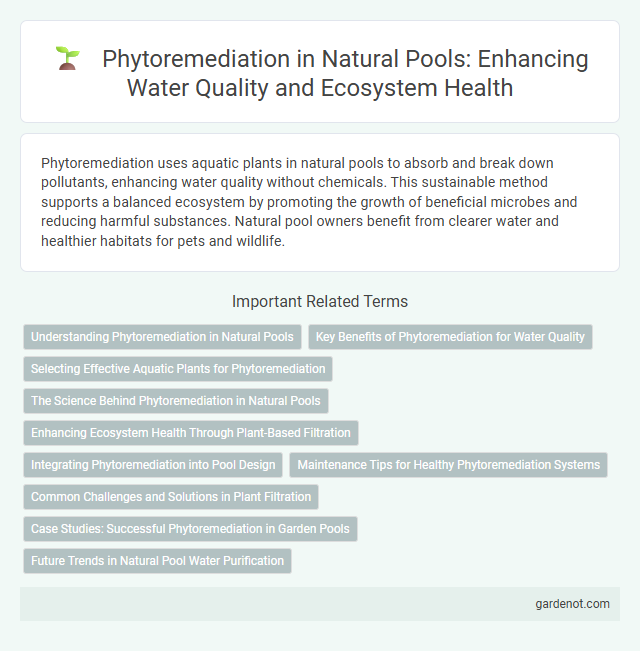Phytoremediation uses aquatic plants in natural pools to absorb and break down pollutants, enhancing water quality without chemicals. This sustainable method supports a balanced ecosystem by promoting the growth of beneficial microbes and reducing harmful substances. Natural pool owners benefit from clearer water and healthier habitats for pets and wildlife.
Understanding Phytoremediation in Natural Pools
Phytoremediation in natural pools utilizes aquatic plants to naturally cleanse water by absorbing, degrading, or stabilizing pollutants such as heavy metals, nutrients, and organic compounds. Species like water hyacinth, cattails, and reeds play a critical role in improving water quality by filtering contaminants through their roots and promoting microbial activity in the sediment. This eco-friendly remediation process enhances biodiversity and maintains the ecological balance of natural pools without the need for chemical treatments.
Key Benefits of Phytoremediation for Water Quality
Phytoremediation enhances water quality by using aquatic plants to absorb, degrade, and immobilize pollutants such as heavy metals, nutrients, and organic contaminants in natural pools. This eco-friendly process reduces harmful algal blooms and increases oxygen levels, promoting a balanced aquatic ecosystem. The integration of native plant species supports biodiversity while minimizing maintenance and chemical treatments required for water purification.
Selecting Effective Aquatic Plants for Phytoremediation
Selecting effective aquatic plants for phytoremediation in natural pools involves prioritizing species known for rapid growth, high biomass production, and strong pollutant uptake capabilities such as water hyacinth (Eichhornia crassipes), duckweed (Lemna minor), and cattails (Typha latifolia). These plants excel at absorbing heavy metals, nitrates, and phosphates, thereby improving water quality by reducing eutrophication and toxic contaminant levels. Optimal plant selection also considers local climate, water chemistry, and biodiversity to ensure sustainable ecosystem balance and long-term phytoremediation success.
The Science Behind Phytoremediation in Natural Pools
Phytoremediation in natural pools utilizes specific aquatic plants to absorb, transform, and remove contaminants such as heavy metals and organic pollutants from the water. These plants engage in processes like phytoextraction, phytodegradation, and rhizofiltration, effectively improving water quality by breaking down toxic substances into less harmful compounds. The science behind this natural filtration method relies on plant-root symbiosis with microorganisms, which enhances pollutant degradation and nutrient cycling within the pool ecosystem.
Enhancing Ecosystem Health Through Plant-Based Filtration
Phytoremediation in natural pools utilizes aquatic plants like cattails, reeds, and water hyacinths to filter pollutants and absorb excess nutrients, effectively improving water quality and supporting biodiversity. These plants enhance ecosystem health by promoting oxygenation, providing habitat for microorganisms, and stabilizing sediment. By integrating plant-based filtration, natural pools maintain balanced ecosystems with reduced chemical inputs and resilient water purification processes.
Integrating Phytoremediation into Pool Design
Integrating phytoremediation into natural pool design enhances water purification by utilizing aquatic plants such as water hyacinth and cattails, which absorb and break down pollutants and excess nutrients. These plants establish a balanced ecosystem that naturally reduces algae growth and maintains clear, chemical-free water. Effective placement of phytoremediation zones around filtration basins ensures continuous water cleansing, promoting sustainable and eco-friendly swimming environments.
Maintenance Tips for Healthy Phytoremediation Systems
Phytoremediation systems in natural pools require regular monitoring of aquatic plant health to ensure efficient toxin absorption and nutrient cycling. Maintaining optimal water quality through balanced pH levels, adequate sunlight, and nutrient control supports robust plant growth and microbial activity essential for contaminant breakdown. Periodic removal of excess biomass prevents decay-related oxygen depletion, promoting a sustainable and effective phytoremediation process.
Common Challenges and Solutions in Plant Filtration
Phytoremediation in natural pools often faces challenges such as seasonal plant dieback, nutrient overload, and algal blooms, which can compromise water clarity and ecosystem balance. Selecting resilient macrophytes with high nutrient uptake efficiency, alongside regular harvesting and maintaining optimal plant density, mitigates these issues. Integrating microbial communities with plant root zones enhances pollutant degradation, providing a sustainable solution for maintaining water quality in natural filtration systems.
Case Studies: Successful Phytoremediation in Garden Pools
Phytoremediation in natural garden pools effectively improves water quality by utilizing aquatic plants such as water hyacinth and duckweed, which absorb and break down pollutants like nitrates and heavy metals. Case studies demonstrate that these plants can reduce contaminants by up to 70% within weeks, creating healthier ecosystems and enhancing biodiversity. Successful implementations include urban garden pools in Berlin and Tokyo, where continuous monitoring showed sustained pollutant reduction and clear water maintenance without chemical treatments.
Future Trends in Natural Pool Water Purification
Phytoremediation in natural pool water purification is evolving with advancements in plant biotechnology and microbial symbiosis, enhancing contaminant degradation efficiency. Innovative integration of genetically optimized aquatic plants improves nutrient uptake and pollutant absorption, reducing reliance on chemical treatments. Future trends emphasize sustainable systems leveraging bioengineered flora for self-regulating water purification, promoting eco-friendly recreation environments.
Phytoremediation Infographic

 gardenot.com
gardenot.com